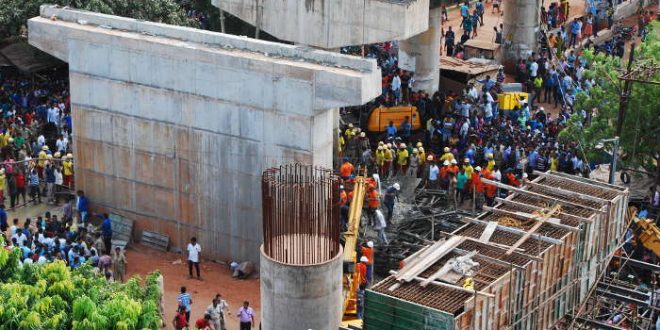Dhanada K Mishra
Around 11 PM on January 24, an under-construction reinforced concrete roof of a connecting building between the old and new terminal buildings at the Biju Patnaik International Airport in Bhubaneswar collapsed. One labourer died and another was seriously injured. The building was spread over 12,000 square foot and the span being cast was about 20 feet, newspaper reports said. From photographs published along with news reports, the roof was being cast on the ground floor and the construction site presented a very disorganised and chaotic look – common for most such sites in Odisha. The Airport Authority of India (AAI)-approved project is valued at Rs 56 core and it was in its initial stage, well behind schedule, with the completion date in October. AAI and Government of Odisha have both have announced independent inquiry committees to look into the causes that led to the accident. Four persons, including the Managing Director of the firm responsible for the construction, have been taken into custody.
Only a month before this accident, a steel girder of an under-construction railway overbridge fell on the tracks disrupting railway traffic and infrastructure. In June 2019, a reinforced concrete bridge over Budhabalanga river near Remuna, connecting districts of Balasore and Mayurbhanj, collapsed. Most notably in September 2017, there was a major accident during the casting of concrete on a railway over-bridge in Bomikhal in heart of Bhubaneswar in which one member of the public died and 11 persons were injured. This ill-fated bridge suffered yet another eminently preventable accident in which a labourer died and several were injured in May 2018. Only after the second incident, the original firm was debarred from continuing with the construction. This bridge was finally inaugurated after missing seven deadlines by the Chief Minister on February 20, 2019. Much to the shock and horror of the people, the bridge had such an elementary design flaw that the traffic was completely in a jam trying to use the bridge and major restrictions had to be imposed to make it usable. It remains a standing testament to our utter incompetence in design, planning and executing of what would be elementary and routine civil engineering work in most of the world.
While in all of the above cases, prompt action has been promised, inquiry committees have been formed, mostly consisting of government officers who themselves may be partly to blame for such a sad state of affairs. None of the inquiry reports ever see the light of the day or recommendations implemented and we move on to the next accident and another inquiry committee. In comparison, when a pre-fabricated, pre-cast concrete, post-tensioned pedestrian bridge failed during installation over a highway in Florida in March last year killing six and injuring 10 people, this is how an article described the rare such accident in the USA – “It was to be a showcase of advanced bridge technology, a centrepiece of urban development in Miami-Dade County. It was equipped with titanium dioxide–impregnated self-cleaning concrete that would always sparkle white in the Florida sun. It was designed to withstand a Category 5 hurricane. And it was supposed to last 100 years. Designed to withstand the biggest storms nature could throw at it, the structure couldn’t withstand a perfect storm of hasty planning, managerial incompetence, and human hubris.” Just last week I received the investigation report in my mailbox from the American Concrete Institute (ACI) being a member of the august body. The report drafted by the best experts available in the country by the National Transport Safety Board (NTSB) identified a faulty design calculation and lack of response to initial cracking in the concrete as the root cause. I hope and wish the members of our expert panels would look at such publicly available reports before they undertake the investigation. They should also make their findings widely available so that all stakeholders can learn from these repeating disasters which will help greatly minimise their chances of recurrence.
According to a report, over a thousand deaths occurred in 2018 due to road accidents in Odisha and the mishaps are directly attributable to design defects and maintenance issues such as deadly potholes. That is over three deaths a day. The number of injured and the economic loss would run into thousands and crores respectively. Potholes killed 35 in 2018, steep grade roads proved killer for another 97, while ongoing roadworks/roads under construction abruptly ended lives of 197 persons and other design faults killed 827 with a major factor being driving in inebriated state. Most of the victims tend to be male and in the peak age group of 25-45 years with dependent families, including parents, wives and children back home. It’s an imaginably sad tragedy that these accidents cannot be prevented, if not eliminated. Most pothole-related accidents take place in monsoon and at night. It’s a public health crisis that needs a prompt response. Unlike the Florida bridge accidents, the failures we encounter daily in our infrastructure is rooted in far less complex factors such as poor training, lack of safety culture, poor quality consciousness and above all pervasive shadow of corruption. Unfortunately, the challenges we face are far more socio-political than technical. Hence, it will take strong political will and social awareness to bring this menace under control.
The author is a civil engineering professor and principal of KMBB College of Engineering and Technology currently visiting Hong Kong University of Science and Technology as a Research Scholar. He can be reached by email at dhanadam@gmail.com

